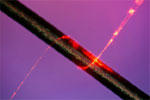Silica nanowires
Using a two-step drawing process, we fabricate long freestanding silica wires with diameters down to 50 nm that show atomic-level surface smoothness and excellent diameter uniformity. While other researchers have synthesised nanowires with smaller diameters, previous work has not yielded such uniform and smooth structures. The length of the wires can be up to tens of millimeters, giving them an aspect ratio larger than 50,000. Light can be launched along these wires by optical evanescent coupling. The wires allow single-mode operation and have very low optical losses within the visible to near-infrared spectral range. Mechanical tests show that the wires have tensile strength in excess of 5 GPa -- stronger than spider silk. The wires are also resilient and flexible, easily bending into microscopic loops.
Wrapping light around a hair,
at
InternationalConference on Applications of Lasers and Electro-Optics 2004 (San Francisco, CA),
Monday, October 4, 2004:
Wrapping light around a hair: silica nanowires for optical components,
at
Hanscom Sigma Xi Chapter Joint Meeting with the IEEE Life Members, MIT Lincoln Labs (Lincoln, MA),
Tuesday, November 8, 2005:
Wrapping light around a hair,
at
Current Science & Technology Stage Presentation, Museum of Science (Boston, MA),
Saturday, April 21, 2007:
Wrapping light around a hair,
at
RET/REU Seminar, Harvard University (Cambridge, MA),
Tuesday, June 24, 2008
Wrapping light around a hair,
at
Physics Seminar, Indiana University Purdue University Indianapolis (Indianapolis, IN),
Thursday, March 4, 2010:
Nonlinear optics at the nanoscale,
at
Zernike Institute for Advanced Materials Symposium, Universiteit Groningen (Groningen, Netherlands),
Thursday, October 25, 2012:
Nonlinear optics at the nanoscale,
at
University of Florida (Gainesville, FL),
Monday, February 16, 2015:
Subwavelength-diameter silica wires for microscale optical components,
at
SPIE Europe International Symposium: Microtechnologies for the New Millennium (Sevilla, Spain),
Tuesday, May 10, 2005:
Wrapping light around a hair,
at
Australian Institute of Physics 17th Biennial Congress 2006, Brisbane Convention and Exhibition Centre (Brisbane, Queensland, Australia),
Tuesday, December 5, 2006:
Wrapping light around a hair,
at
Baetjer Colloquium, Princeton University (Princeton, NJ),
Thursday, November 15, 2007:
Nonlinear optics at the nanoscale,
at
Physics Colloquium, Temple University (Philadelphia, PA),
Monday, September 21, 2009:
Nonlinear optics at the nanoscale,
at
Physics Colloquium, Lehigh University (Bethlehem, PA),
Thursday, April 28, 2011:
Nonlinear optics at the nanoscale,
at
Louisiana State University (Baton Rouge, LA),
Monday, April 28, 2014:
Supercontinuum and second harmonic generation in amorphous silica nanowires,
at
Glass & Optical Materials Division Fall 2004 Meeting (Cocoa Beach, FL),
Wednesday, November 10, 2004:
Supercontinuum in silica nanowires,
at
Photonics West 2006 (San Jose, CA),
Thursday, January 26, 2006:
 We developed a process for fabricating silica nanowires with a diameter of only one thousandth the diameter of a hair. Although significantly narrower than the wavelength of light, these nanowires can act as "rails" for light and are promising building blocks for future microphotonic devices.
We developed a process for fabricating silica nanowires with a diameter of only one thousandth the diameter of a hair. Although significantly narrower than the wavelength of light, these nanowires can act as "rails" for light and are promising building blocks for future microphotonic devices.